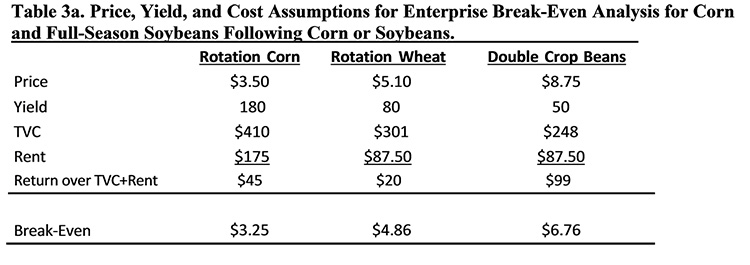Wheat, double-crop soybeans look profitable in 2019
Wheat, double-crop soybeans look profitable in 2019

As Kentucky grain producers look ahead to 2019, they may want to consider adding wheat seeding to their plans this fall. The combination of wheat followed by double-crop soybeans is appearing to be more profitable for the upcoming marketing year compared to a corn-soybean rotation, said Todd Davis, University of Kentucky agricultural economist.
“For the past couple of seasons, second-year soybeans were a profitable alternative to corn, however, the soybean market fundamentals are not as optimistic heading into 2019,” said Davis, extension grain marketing specialist in the UK College of Agriculture, Food and Environment.
Davis used average yields and projected harvest cash prices of $3.50 per bushel for corn, $8.35 per bushel for full-season soybeans, $8.75 per bushel for double-crop soybeans and $5.10 per bushel of wheat. He then subtracted total variable costs and cash rents to arrive at a projected return and break-even price for each crop. In a corn-soybean rotation, returns were $45 per acre for corn, but full-season soybeans had a loss of $16 per acre. Second-year soybeans showed a loss of $46 per acre. Break-even prices are $3.25 per bushel for corn, $8.66 per bushel for full-season soybeans and $9.29 per bushel for second-year soybeans.
In contrast, wheat had a return of $20 per acre and double-crop soybeans had a return of $99 per acre. The break-even price for wheat is $4.86 per bushel. It was $6.76 per bushel for double-crop soybeans.
“Managers who have not seeded wheat for a few years should use their own yields and cost information to budget potential returns from growing wheat followed by double-crop soybeans in 2019 and compare it to the profitability of maintaining a corn-soybean rotation,” Davis said. “The wheat market is currently offering profit potential.”
Davis’ calculations do not take forward contracting before harvest into consideration. Davis also recommended that producers purchase crop insurance to protect themselves against extreme losses and significantly lower prices.
Agricultural Economics Extension

